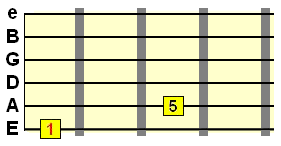Home › Q&A
Power chord progressions
Question by Billy
(Sheffield)
Question: Because 5th chords (power chords) are diads, what do I do with them in relation to chord progressions? I used to just use them as an everyday thing but now that I've started to learn about chord progressions, it's knocked my confidence using them.
Answer
Power chords are pretty versatile for writing chord progressions because they have no major or minor harmonic "restrictions".
When writing a chord progressions specifically using 5th chords, experiment first with different interval movements using those root E, A and D string power chord shapes...
For example, a minor 3rd movement (note that these interval movements can be made in any position)...
Perfect 4th interval...
Perfect 5th interval...
Major 6th interval...
...and all in between.
However, don't get too dogmatic with it all. Just play around with linking these movements together and see what kind of progression it shapes.
Turning regular chord progressions into power chord progressions
Essentially, a power chord is just a chord stripped down to its root and 5th. Since both major and minor chords use the root-5th tones, all you have to do is play each chord in your progression as standard barre chords and then cut them down to the root-5th strings.
For example, if we had the following progression...
A - F#m - F - Bm
I could use the following barre chord shapes...
Now we can strip them down to root-5th diads using the bottom 3 strings of these barre forms...
You may find then when you strip your progressions down like this they lose a lot of their substance and feel. A good vocal harmony will ensure that your power chord progressions don't sound too disjointed (unless of course that's the sound you want).
Also, remember to try using more unconventional movements involving semitone (one fret) and chromatic sequences. This technique is used a lot in metal and just wouldn't work with standard major/minor chords.
There are also other diads you can use to replace standard chord forms. See the metal guitar chords lesson for some ideas.